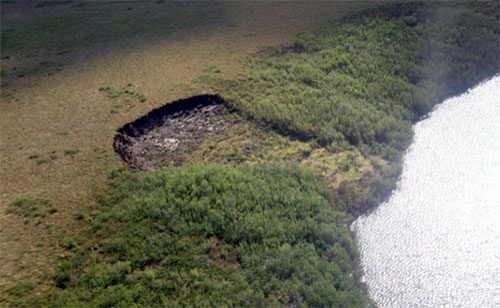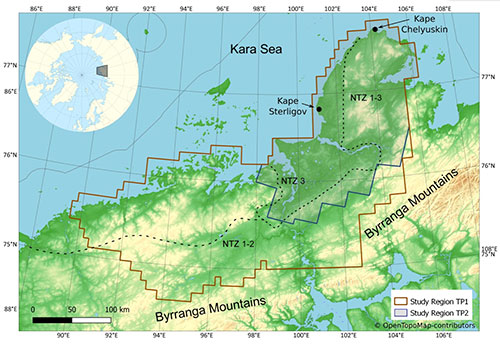This medium-sized thaw slump in Canada’s Mackenzie River Delta is about 260 feet wide and with a headwall of about 10 to 15 feet. It formed closer to the lake, expanding upslope by many feet each summer. |
“Permafrost landscapes are expected to change profoundly over the next decades,” said Simon Zwieback, a University of Alaska Fairbanks Geophysical Institute assistant professor and one of the research paper’s authors. “Among the many consequences of this is the release of greenhouse gasses such as carbon dioxide, which can exacerbate climate change.”
Similar thaw slumps are also widespread in Russia’s Yamal Peninsula in Siberia, in northwestern Canada and in Canada’s Arctic archipelago.
Doctoral student Philipp Bernhard of the Swiss Federal Institute of Technology in Zürich and Irena Hajnsek of the Zürich institute and the German Aerospace Center also worked on the research. Zwieback and Hajnsek were Bernhard’s Ph.D. advisors.
The work focused on 10,500 square miles in the northern Taymyr Peninsula of Russia’s Siberia, an area bounded by the Byrranga Mountains to the south and the Kara Sea to the north.
The researchers compared satellite images from two time periods — 2010-2017 and 2018-2021 — to note elevation changes and movement of debris and of the slump’s exposed leading edge. They then incorporated a soil organic carbon map and made assumptions about the ground’s ice content and its carbon stores to calculate the amount of organic carbon released.
An ice sheet covered the entire study region around 130,000 years ago, with subsequent periods of ice retreat and advance covering a smaller and smaller area. The most recent retreat occurred at the end of the last ice age and was largely completed 12,000 years ago.
Satellite images revealed the spread of thaw slumps in areas containing remnants of that long-ago ice sheet.
A retreating sheet usually leaves behind substantial quantities of ice covered by clay, sand, gravel and rocks, particularly along the ice sheet’s edges. The retreating sheet that once covered the present-day Taymyr region created several of these ice-rich zones, referred to as ice-marginal zones. Two of those zones are in the researchers’ study area.
This map shows location of the study area and the time periods studied. |
Images of the study area showed an increase in slumps from 82 in the 2010-2017 study period to 1,404 in the 2018-2021 period, with nearly all of that increase occurring during the region’s extremely warm 2020.
The images also showed that the annual volume of affected material increased by about 43 times from the first to second periods.
“The extreme warmth was compounded by there being a lot of ground ice close to the surface,” Zwieback said. “This is due to the long-term legacy of past ice ages but also to the fact that so much of this old ice is still there because summers are usually cool and there are no fires.
“And the ice is not well protected by insulating organic layers because there’s not much life in the harsh climate,” he said.
Alaska has thaw slumps but not nearly as many as those in Canada and Russia. Alaska also has other hillslide deformations caused by thawing permafrost, and these may contribute to climate change, Zwieback said.
Little research on such a large geographic scale as that in the Taymyr Peninsula exists about thaw slumps. The work of Zwieback, Bernhard and Hajnsek shows that the carbon release from thawing Arctic hillsides must be accounted for in assessing the Arctic’s carbon cycle. Researchers also need to quantify how much of it is turned into greenhouse gasses such as carbon dioxide.
“The big challenge is to quantify and predict where, when and how much carbon dioxide is released,” Zwieback said.
This article is provided as a public service by the University of Alaska Fairbanks, Geophysical Institute. Rod Boyce [rcboyce@alaska.edu] is a science writer with the Geophysical Institute. |
Representations of fact and opinions in comments posted are solely those of the individual posters and do not represent the opinions of Sitnews.
Send a letter to the editor@sitnews.us
SitNews ©2022
Stories In The News
Ketchikan, Alaska
Articles & photographs that appear in SitNews are considered protected by copyright and may not be reprinted without written permission from and payment of any required fees to the proper freelance writers and subscription services.
E-mail your news & photos to editor@sitnews.us
Photographers choosing to submit photographs for publication to SitNews are in doing so granting their permission for publication and for archiving. SitNews does not sell photographs. All requests for purchasing a photograph will be emailed to the photographer.


